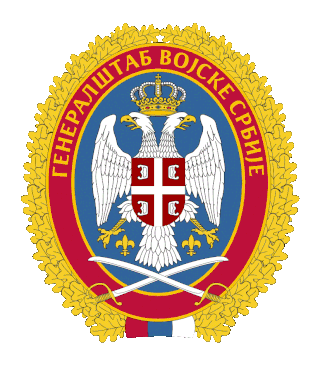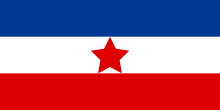
The Yugoslav People's Army, also called the Yugoslav National Army, was the military of the Socialist Federal Republic of Yugoslavia and its antecedents from 1945 to 1992.

The Belgrade offensive or the Belgrade strategic offensive operation was a military operation during World War II in Yugoslavia in which Belgrade was liberated from the German Wehrmacht through the joint efforts of the Soviet Red Army, Yugoslav Partisans, and the Bulgarian Army. Soviet forces and local militias launched separate but loosely cooperative operations that undermined German control of Belgrade and ultimately forced a retreat. Martial planning was coordinated evenly among command leaders, and the operation was largely enabled through tactical cooperation between Josip Broz Tito and Joseph Stalin that began in September 1944. These martial provisions allowed Bulgarian forces to engage in operations throughout Yugoslav territory, which furthered tactical success while increasing diplomatic friction.

The Yugoslav Ground Forces was the ground forces branch of the Yugoslav People's Army (JNA) from 1 March 1945 until 20 May 1992 when the last remaining remnants were merged into the Ground Forces of the new Federal Republic of Yugoslavia, under the threat of sanctions.

The General Staff of the Serbian Armed Forces is the highest authority within the Serbian Armed Forces and a significant command entity with numerous organizational units under its direct command.

The 1st Cavalry Division of the Royal Yugoslav Army was established in 1921, soon after the creation of the Kingdom of Serbs, Croats and Slovenes, which became the Kingdom of Yugoslavia in 1929. In peacetime it consisted of two cavalry brigade headquarters commanding a total of four regiments. It was part of the Yugoslav 1st Army Group during the German-led World War II Axis invasion of Yugoslavia in April 1941, with a wartime organisation specifying one cavalry brigade headquarters commanding two or three regiments, and divisional-level combat and support units.

The Guard of the Serbian Armed Forces is an honour guard unit of the Serbian Armed Forces under the direct command of the General Staff. Besides ceremonial duties its main tasks include security and logistics missions.

The Operation Draufgänger was a German Wehrmacht military operation against the Yugoslav Partisans at the Montenegrin-Serbian border area, aimed at breaking the Partisan foothold on the Lim river which was a potential penetration point into Serbia. In turn, it was a Partisan counter-operation, known as the Andrijevica Operation. The operation began on 18 July on the Čakor–Gusinje–Andrijevica–Berane line, when Kampfgruppe E burnt down at least 16 villages and killed several hundreds inhabitants. From different directions, German troops attacked villages and a part approached Andrijevica, pushed out parts of two Partisan brigades, and then took over the town on 19 July and continued attacking. The staffs of the Partisan brigades assessed the combined German forces as inadequate and self-initiatively decided to attacks, resulting in great German losses. With the possibility to surround and destroy, the II Assault Corps gave the operational command on 23 July on general attack. From different directions the German troops were surrounded in the wider region of Murino on 24 July. On 28 July the Partisan 2nd, 5th and 17th divisions were ordered to move across the Ibar, which gave the opportunity for the 14th Regiment SS to break through Čakor towards Peć, while larger part of the 21st Division SS broke and many Albanians deserted. The German troops were decisively defeated, and the Partisans moved for action in Serbia. Operation Rübezahl followed.

The Main Staff of the Serbian Army of Krajina was the highest professional and staff organ for preparation and use of the Serbian Army of Krajina in war and in peace.

The First Proletarian Division of the NOVJ was formed on November 1, 1942 from the First Proletarian Brigade, the Third Proletarian Brigade and the Third Krajina Brigade in Bosanski Petrovac, under command of Koča Popović. It was considered one of the elite units of the NOVJ.

The Bihać operation was a military operation conducted by Yugoslav partisans against the Independent State of Croatia (NDH) and Nazi Germany during World War II. The aim of the operation was to capture Bihać and the surrounding towns to connect Partisan held areas in Bosanska Krajina, and Knisnka Krajina. The battle for the city of Bihać lasted from 2 November to 4 November 1942. After capturing the city, the partisans continued to fight in surrounding areas until 15 November. The operation resulted in a major Partisan victory, with Bihać and the surrounding areas being captured, and the NDH suffering significant casualties.

The 6th Proletarian Assault Lika Division "Nikola Tesla" was a Yugoslav Partisan division formed on 22 November 1942. It was formed from the 1st, 2nd, and 3rd Lika Brigades. On 11 November 1943, it became part of the 4th Corps and later a part of the 1st Corps. It operated in Dalmatia until November 1943 when it crossed into Bosnia, later it fought in Serbia and on the Syrmian Front. From October 1944, the 22nd Serbian Kosmaj Brigade also fought as part of the division, and in December 1944 an Artillery Brigade was formed within the division.

The 17th East Bosnia Assault Division was Yugoslav Partisan division formed on 2 July 1943. The division was formed from the 6th East Bosnia Brigade, the 1st Majevica Brigade and Majevica Detachment. Gligorije Mandić was a commander of the division while its political commissar was Branko Petričević. The division was under the direct command of the Supreme Headquarters until 20 September 1943 when it came under the command of the 3rd Corps. During a brief time in May and June 1944, it was again under the command of the Supreme Headquarters, following that it became a part of the 2nd Corps. The division mostly fought in Bosnia and Serbia.

The 21st Assault Serbian Division was a Yugoslav Partisan division formed on Radan mountain on 20 May 1944. It was formed as 1st Serbia Division, but it was renamed on 14 June 1944. Upon formation it had around 1,000 soldiers in three brigades, those being: the 4th, 5th and 6th Serbia Divisions. Commander of the division was Miloje Milojević. The division mostly fought against Chetniks and Germans in occupied Serbia.

The 23rd Serbia Division was a Yugoslav Partisan division formed on 6 June 1944 as the 3rd Serbia Division in Toplica. It was formed from the 7th and 9th Serbia Brigades. On 17 June 1944, the 14th Serbia Brigade was added to the division which at the time numbered around 2,000 soldiers. The division was under the direct command of the Supreme Headquarters until 6 September 1944 when it became part of the 14th Corps. On 9 December 1944, it came under the command of the Southern Operational Group and in January 1945 it became part of the 2nd Army.

The 24th Serbia Division was a Yugoslav Partisan division formed on 10 June 1944 as the 4th Serbia Division in Jablanica. It was formed from the 11th and 17th Serbia Brigades which numbered around 2000 fighters in total. Soon after the formation the 13th and the 15th Serbia Brigades were also added to the division. The division was under the direct command of the Supreme Headquarters until 6 September 1944 when it became a part of the 13th Corps. Its commander was Mile Čalović while its political commissar was Dimitrije Vrbica.

The 25th Serbia Division was a Yugoslav Partisan division formed on 10 June 1944 in Jošanica. It was formed from the 16th, 18th and 19th Serbia Brigades. Upon formation it had around 3,000 soldiers, it grew to around 12,000 by December 1944. The division was direct command of the Supreme Headquarters until 6 September 1944. It became a part of the 2nd Army in January 1945.
Mihailo Rašić was a Serbian military leader. He served as Royal Yugoslav Army general and Minister of War of the Kingdom of Serbia in World War I. After the war, in the Kingdom of Yugoslavia, he continued his service as Minister of the Army and Navy in the Ministry of Defence. He served as the 16th dean of the Academic Board of the Military Academy in Belgrade (1912-1914).

The 5th Krajina Division was a Yugoslav Partisan division formed in Glamočko polje on 9 November 1942.

The 30th Slovenia Division was a Yugoslav Partisan division formed on 6 October 1943 in Western Slovenia.










